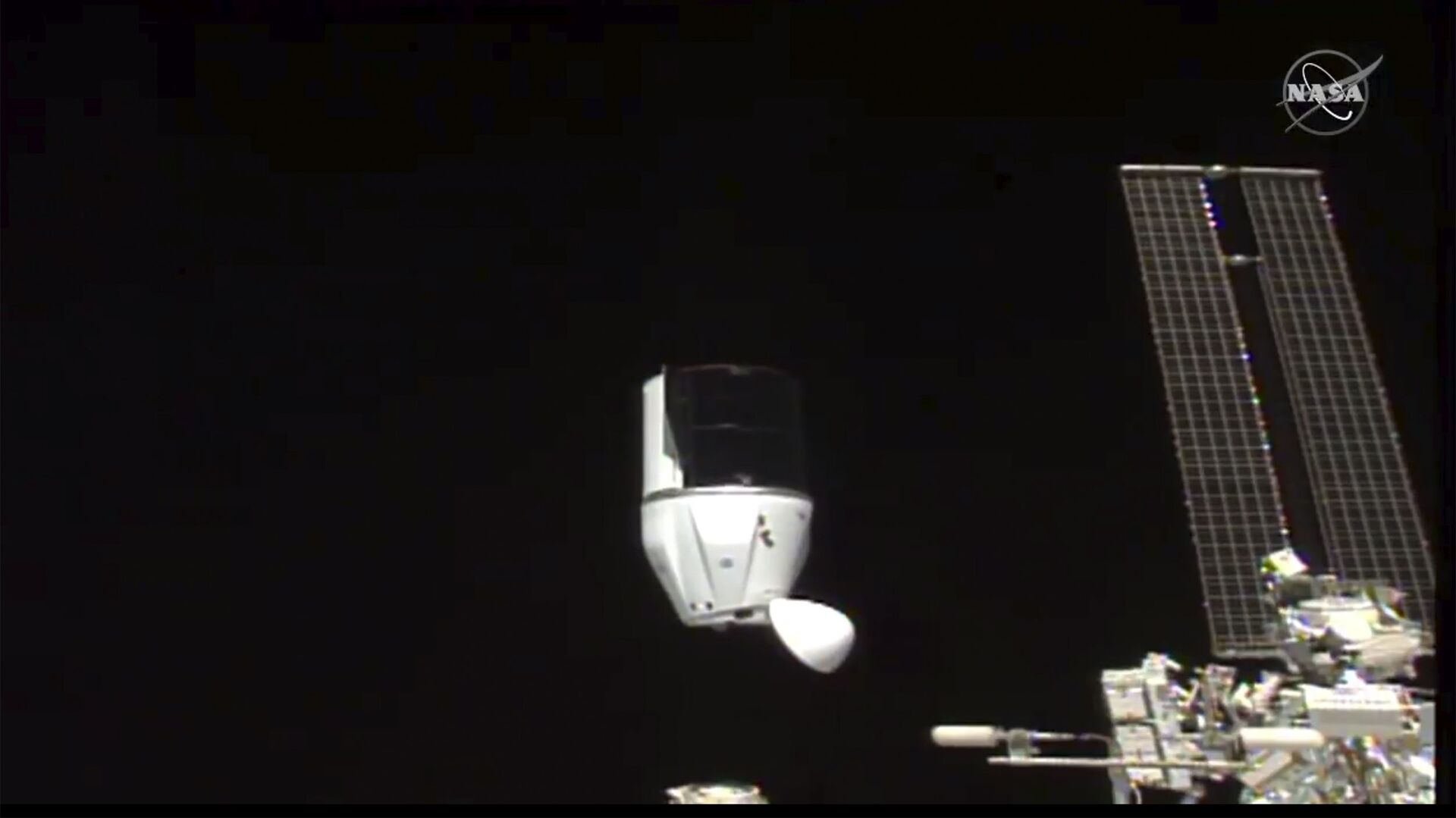https://sputnikglobe.com/20230317/spacex-launch-saw-successful-delivery-of-unique-laser-energy-experiment-to-iss-1108488189.html
SpaceX Launch Saw Successful Delivery of Unique Laser Energy Experiment to ISS
SpaceX Launch Saw Successful Delivery of Unique Laser Energy Experiment to ISS
Sputnik International
On March 15, the first launch of the Falcon-9 with the Cargo Dragon cargo spacecraft took place from the Kennedy Space Center at Cape Canaveral. The mission was successful and the spacecraft has already docked with the ISS.
2023-03-17T04:01+0000
2023-03-17T04:01+0000
2023-03-17T03:59+0000
science & tech
cargo
cape canaveral
launch
falcon 9
spacex falcon 9
international space station (iss)
iss
naval research laboratory
scientific experiments
https://cdn1.img.sputnikglobe.com/img/07e5/01/0d/1081749838_0:131:2500:1537_1920x0_80_0_0_bfdb913bfda7bf3967da8ea2e9949c51.jpg
The SpaceX Dragon cargo carried, among other things, the Space Wireless Energy Laser Link (SWELL) experiment developed by the US Naval Research Laboratory (NRL), which will attempt to establish an optical link between laser transmitters and receivers inside a 1.7-meter-long tube. The experiment is a refinement of laser radiation technology that transmits energy in the form of electromagnetic waves without mass.Thus, in the absence of the mass factor, the transmission of electrical energy using electromagnetic waves means that power can be transmitted from place to place almost at the speed of light. The NRL states that the feasibility and safety of laser radiation has been proven on the ground.Experiments in space could lead to applications that include transmitting power from a satellite to space, transmitting energy from space generators back to Earth for use on Earth, or supporting missions exploring permanently shadowed craters on the moon. Eventually, energy radiation could be used to launch spacecraft at record speeds to explore interstellar space.But so far, no demonstration of energy transfer in orbit has tested the ability to transfer energy over a distance of more than a meter with an end-to-end efficiency of more than 1%. The SWELL experiment aims to do just that and will collect data on how the equipment performs in the space environment.Other payload experiments included:The Cargo Dragon will stay with the ISS for about a month, after which time it will be deorbited and its descent capsule will land in the Atlantic near the Florida coast. The ship will bring the results of experiments carried out by the ISS crew in orbit, weighing more than 2.3 tons.
cape canaveral
Sputnik International
feedback@sputniknews.com
+74956456601
MIA „Rossiya Segodnya“
2023
News
en_EN
Sputnik International
feedback@sputniknews.com
+74956456601
MIA „Rossiya Segodnya“
Sputnik International
feedback@sputniknews.com
+74956456601
MIA „Rossiya Segodnya“
cargo dragon, swell, iss, falcon 9 launch, new experiments on iss, us nrl laser swell experiment, glowbug, stellar occultation hypertemporal imaging payload, gamma-ray bursts. space experiments
cargo dragon, swell, iss, falcon 9 launch, new experiments on iss, us nrl laser swell experiment, glowbug, stellar occultation hypertemporal imaging payload, gamma-ray bursts. space experiments
SpaceX Launch Saw Successful Delivery of Unique Laser Energy Experiment to ISS
On March 15, the first launch of the Falcon-9 with the Dragon cargo spacecraft took place from the Kennedy Space Center at Cape Canaveral. The mission proved successful as the spacecraft docked with the International Space Station.
The SpaceX Dragon cargo carried, among other things, the Space Wireless Energy Laser Link (SWELL) experiment developed by the US Naval Research Laboratory (NRL), which will attempt to establish an optical link between laser transmitters and receivers inside a 1.7-meter-long tube.
The experiment is a refinement of laser radiation technology that transmits energy in the form of electromagnetic waves without mass.
Thus, in the absence of the mass factor, the transmission of electrical energy using electromagnetic waves means that power can be transmitted from place to place almost at the speed of light. The NRL states that the feasibility and safety of laser radiation has been proven on the ground.
"This is the next step in extending this capability for space, lunar and planetary applications," Chris DePuma, SWELL program manager, said. "Power beaming is poised as a critical enabler for power distribution on the moon and elsewhere in space."
Experiments in space could lead to applications that include transmitting power from a satellite to space, transmitting energy from space generators back to Earth for use on Earth, or supporting missions exploring permanently shadowed craters on the moon.
Eventually, energy radiation could be used to launch spacecraft at record speeds to explore interstellar space.
"With this modest experiment, we will identify key focus areas for developing links of greater power and longer distance for space," said Paul Jaffe, electronics engineer and SWELL principal investigator. "By employing laser transmitters and photovoltaic receivers, power beaming links will be established that will pave the way for rapid, resilient and flexible energy delivery systems."
But so far, no demonstration of energy transfer in orbit has tested the ability to transfer energy over a distance of more than a meter with an end-to-end efficiency of more than 1%. The SWELL experiment aims to do just that and will collect data on how the equipment performs in the space environment.
"Power beaming might also be used for distributing power for and around Earth, including from satellites that collect solar energy in space," Jaffe said. "SWELL is the next step into this new frontier."
Other payload experiments included:
Electrical thrust analyzer from the Air Force Academy
Glowbug instrument, a miniature gamma-ray telescope designed to detect cosmic rays called
gamma-ray burstsStellar Occultation Hypertemporal Imaging payload, which contains a useful load to test a high-frequency camera that could in the future be used to observe how air bends or refracts light from a star as it passes through the atmosphere
The Cargo Dragon will stay with the ISS for about a month, after which time it will be deorbited and its descent capsule will land in the Atlantic near the Florida coast. The ship will bring the results of experiments carried out by the ISS crew in orbit, weighing more than 2.3 tons.

